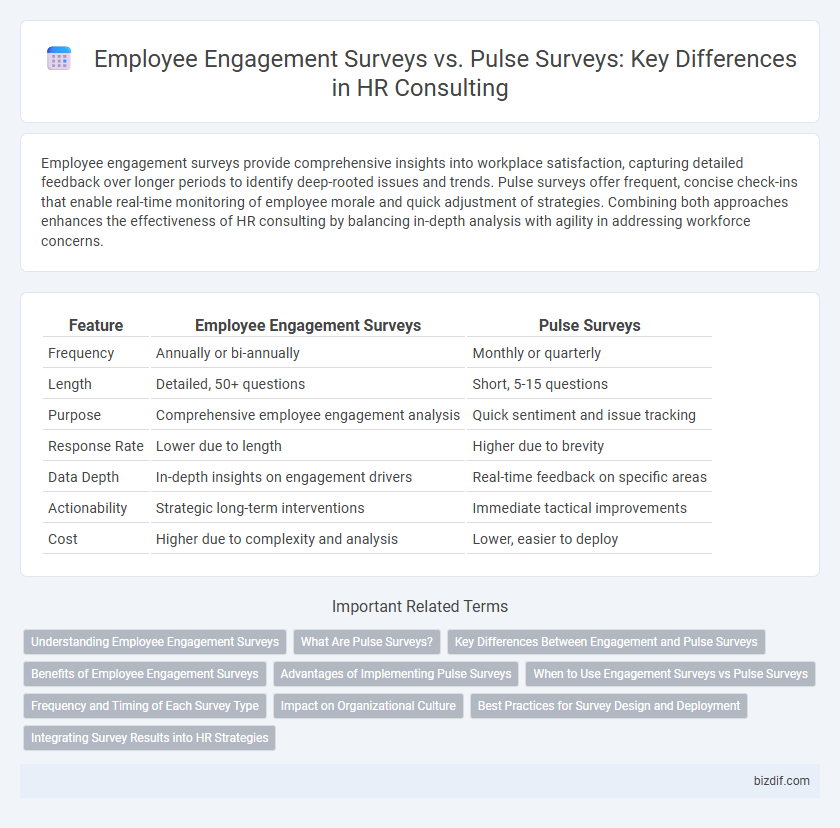Employee engagement surveys provide comprehensive insights into workplace satisfaction, capturing detailed feedback over longer periods to identify deep-rooted issues and trends. Pulse surveys offer frequent, concise check-ins that enable real-time monitoring of employee morale and quick adjustment of strategies. Combining both approaches enhances the effectiveness of HR consulting by balancing in-depth analysis with agility in addressing workforce concerns.
Table of Comparison
| Feature | Employee Engagement Surveys | Pulse Surveys |
|---|---|---|
| Frequency | Annually or bi-annually | Monthly or quarterly |
| Length | Detailed, 50+ questions | Short, 5-15 questions |
| Purpose | Comprehensive employee engagement analysis | Quick sentiment and issue tracking |
| Response Rate | Lower due to length | Higher due to brevity |
| Data Depth | In-depth insights on engagement drivers | Real-time feedback on specific areas |
| Actionability | Strategic long-term interventions | Immediate tactical improvements |
| Cost | Higher due to complexity and analysis | Lower, easier to deploy |
Understanding Employee Engagement Surveys
Employee Engagement Surveys provide comprehensive insights into workforce satisfaction by measuring multiple dimensions such as job satisfaction, communication effectiveness, and organizational culture. These surveys typically involve detailed questionnaires conducted annually or biannually, allowing HR consultants to identify long-term trends and areas for strategic improvement. The in-depth data collected supports targeted action plans that enhance employee retention, productivity, and overall organizational performance.
What Are Pulse Surveys?
Pulse surveys are short, frequent assessments designed to quickly gauge employee sentiment and workplace engagement, typically conducted weekly or monthly. They provide real-time feedback on specific issues, allowing HR teams to identify trends and address concerns promptly. These surveys complement traditional employee engagement surveys by offering continuous insights into employee morale and organizational culture.
Key Differences Between Engagement and Pulse Surveys
Employee engagement surveys typically provide a comprehensive analysis of workforce satisfaction and motivation through detailed questionnaires conducted annually or biannually, offering in-depth insights into long-term employee sentiment. Pulse surveys are shorter, more frequent assessments that capture real-time employee feedback, enabling organizations to quickly identify and address immediate concerns or changes in morale. Key differences include survey length, frequency, and focus--engagement surveys measure overall employee commitment and culture, while pulse surveys track ongoing engagement trends and respond to specific issues.
Benefits of Employee Engagement Surveys
Employee engagement surveys provide comprehensive insights into overall employee satisfaction, motivation, and workplace culture, enabling HR leaders to develop long-term strategies for talent retention. These surveys capture detailed feedback on multiple dimensions such as leadership effectiveness, communication, and career development opportunities that influence employee performance. The deep analysis of aggregated data supports proactive improvements that foster a positive work environment and drive organizational success.
Advantages of Implementing Pulse Surveys
Pulse surveys offer real-time insights into employee sentiment, allowing HR teams to promptly identify and address workplace issues. These frequent, concise surveys improve response rates and provide continuous feedback, fostering a culture of open communication and active employee participation. Implementing pulse surveys enhances agility in HR strategies, leading to increased employee engagement and retention.
When to Use Engagement Surveys vs Pulse Surveys
Engagement surveys are ideal for capturing comprehensive insights into employee satisfaction, motivation, and workplace culture, typically conducted annually or biannually to inform long-term strategic initiatives. Pulse surveys provide real-time feedback on specific issues or changes, allowing HR teams to quickly assess the impact of interventions and address concerns promptly. Deploy engagement surveys during organizational transformations or yearly reviews, while pulse surveys are best used for frequent check-ins, tracking short-term trends, or monitoring employee sentiment after key events.
Frequency and Timing of Each Survey Type
Employee Engagement Surveys are typically conducted annually or biannually, offering a comprehensive overview of workforce sentiment and long-term trends. Pulse Surveys are shorter, deployed frequently--often monthly or quarterly--to capture real-time feedback and quickly address emerging issues. The strategic timing of each survey type ensures a balanced insight into both overarching engagement dynamics and immediate employee concerns.
Impact on Organizational Culture
Employee engagement surveys provide comprehensive insights into long-term organizational culture by capturing detailed employee sentiment across multiple dimensions, enabling strategic cultural transformation. Pulse surveys offer frequent, real-time feedback that helps organizations quickly identify and address emerging issues, maintaining a responsive and adaptive culture. Integrating both survey methods enhances cultural alignment by combining in-depth analysis with ongoing engagement monitoring.
Best Practices for Survey Design and Deployment
Employee engagement surveys typically provide comprehensive insights through detailed questionnaires conducted annually or biannually, while pulse surveys deliver frequent, concise feedback enabling real-time action. Best practices for survey design include using clear, targeted questions aligned with specific organizational goals and ensuring anonymity to increase honesty and response rates. Deploy surveys via accessible platforms, optimize timing to avoid fatigue, and communicate results transparently to foster trust and continuous improvement in employee engagement.
Integrating Survey Results into HR Strategies
Integrating Employee Engagement Surveys and Pulse Surveys into HR strategies enhances data-driven decision-making by providing both comprehensive insights and real-time feedback on workforce sentiment. Employee Engagement Surveys offer in-depth analysis of long-term trends, while Pulse Surveys supply frequent, targeted snapshots that enable agile adjustments to HR initiatives. Combining these survey results allows HR professionals to tailor employee development, retention, and productivity programs more effectively, fostering a dynamic and responsive organizational culture.
Employee Engagement Surveys vs Pulse Surveys Infographic

 bizdif.com
bizdif.com